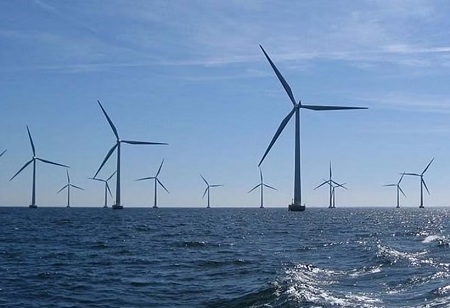A Singapore-based company is closely monitoring the potential of producing wind energy in deep waters off Gujarat and Tamil Nadu as India progresses with its multi-billion-dollar renewable programme. Anil Bhatia, Vice President for Renewable and Hybrid Energy at HBA, said strong winds across deep seas off Gujarat and Tamil Nadu are most suitable for installing bigger wind turbines, ranging from size of 12 MW to 18 MW, and produce 24X7 renewable energy at a competitive price.
"We are closely monitoring potential projects as the Government in New Delhi has recently issued a tender for a block of 4,000 MW wind energy development,". The continuous energy production from such offshore farms makes the production of green ammonia and hydrogen viable and competitive. He compares the offshore mode of managing hydrogen-ammonia production and exports just like the way hydrocarbon production and shipments have been handled around platforms in deep water fields by the offshore oil and gas industry for many decades. "We have the experience of handling such challenging projects,"
Bhatia said on the sidelines of the Offshore South East Asia (OSEA) event held from November 15-17. Global industrial groups are developing and are set to produce 15 MW and 18 MW wind turbines while 12 MW turbines are already operating in some of the major wind-energy-producing regions, especially Europe. Bhatia is confident of installing wind turbines of 12 MW to 18 MW in deep waters off Gujarat and Tamil Nadu. Using its experience of installing platforms and jackets of drilling rigs for the petroleum industry, HBA has the advantage of handling such projects in strong wind conditions, he said. Combined solar and wind energy production, India can be among the first few countries decarbonising at full pace and even exporting green energy, he added. "By putting together the bigger wind turbines and ammonia ships, we can produce the most competitive green ammonia for India and export markets," Bhatia said. Currently, India depends on imported blue ammonia, produced out of petroleum, for its ever-expanding fertiliser needs, he noted.
"But what we see out there in deep seas, offshore production of green ammonia from nitrogen and hydrogen which can then be used widely as a fuel in ships, supplementing coal in power plants to reduce the overall carbon footprint," he said. The global shipping industry has set 'green targets' with newer ships being built to run on hybrid fuel while the automobile industry has started producing electric vehicles and other renewable energy-powered fuels as the world decarbonises. These are some of the major changes taking place globally at a fast pace, he added.
The Japanese have already tested out ammonia for power plants, supplementing coal. Japan plans to import three million tons per year of ammonia, starting from 2026, according to energy industry veteran Hassan Basma, who founded HBA in 2015. As pressure mounts from COP27, environmentalists and the governments' closing in on their Net Zero targets, HBA has advanced its concepts into projects, said Bhatia, adding that a number of blocks have been set up for offshore deep water for wind energy complexes in the Southeast Asian region.
